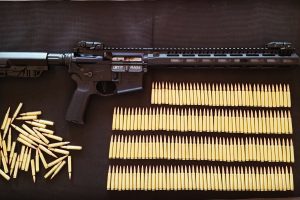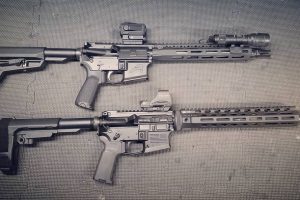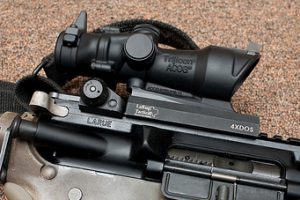What serious shooter doesn’t appreciate a nice trigger when they feel it? There really is something nice about a crisp, clean, and consistent trigger. You feel like you’re in better control of the rifle and when it fires.
Whether these things are true or not isn’t the point, it’s the feeling of control that you like. It is knowing that the trigger is consistent and repeatable. Individuals try to hunt for the “perfect” AR trigger and in doing so they throw away a lot cash and cycle through many excellent options. As consumers, individuals are conditioned by social media, by sponsored shooters, and by bought influencers to think that a great trigger costs a lot of money that something like the LaRue MBT just couldn’t be that good at its price point. That’s not the case here.
A Little MBT History
In 2015 Mark Larue of LaRue Tactical released the MBT (Meticulously Built Trigger) 2 stage trigger. Upon its initial release the MBT 2S trigger retailed for $250.00. At the time that exceeded the price of the excellent Geissele SSA and the market was skeptical. But at certain times of the year such as Black Friday and Christmas, you could catch the trigger on sale for $125.00. At the time, the LaRue triggers were made on an as needed basis and it was common to have to wait for months to receive it. As time went on and as the market changed, Geissele had went up in price but the MBT had come down.
At some point which I do not recall, Mark LaRue decided that he wanted to sell 1 million of these triggers and had lowered the price to $80.00 plus shipping. It still remains at this price today. When I first began to use the LaRue MBT trigger in 2017, the price was about $87.00 shipped to my door and I received them in about 3 weeks. The most recent LaRue MBT trigger I ordered was at the end of June 2020 and I had it before July 4th, 2020. Still about $87.00 to the door.
Back on Track
To date, I’ve handled a lot of very nice combat-quality triggers. Both single stage and two stage. Each have their place and some feel better than others. I will admit that up until I tried the LaRue MBT, I felt that from the viewpoint of a serious shooter that the Geissele line was hard to beat for a quality trigger. But you paid for it.
To date, I have rifles equipped with the following:
- BRD Enhanced Single Stage Trigger
- LaRue Tactical MBT-2S Straight Trigger
- ALG ACT
- Elftmann 3-Gun Trigger
- Rise Armament Single Stage Trigger
Of course, I also have a box full of standard mil-spec triggers from various lower parts kits over time. It’s always good to have spares. And at times I break these out, dust off the trigger stoning jig, and rework those triggers to a much cleaner and crisp single stage trigger.
LaRue MBT Break Down

Upon arrival you will find that the MBT trigger is nicely package in a round metal can with a see through top. Inside the can you will find the trigger with disconnector, hammer, pins, and two different weights of hammer springs nicely package in a plastic tray with cutouts for each part. This is recently a new change to the packaging. Prior to the plastic insert the parts were stored in foam that was cutout for each part. The plastic is a nice change and it comes without an increase in overall price. Most of the time you will also find some extra goodies in the bag that LaRue throws in.
Fit and Finish
Mark LaRue doesn’t make junk. As a matter of fact you will find that most, if not all of LaRue Tactical’s products are over built and stout. This is especially true with their rails. One of which I’ve been running for a while. The MBT trigger is made from solid S7 tool steel plates. The machining and finish on the trigger is very good. One very nice feature that is noticeable right away is that the disconnector is pinned to the trigger assembly. No hassle and no slave pins required for ease of installation.
Trigger Pull and Weight
The LaRue MBT is a two-stage trigger. That means there is a light, but smooth, take-up prior to coming up against a “wall.” Once you reach enough pressure, the wall “breaks” and releases the hammer. As a bonus, the reset on the Laure MBT is unusually pronounced. It is crisp, short and loud. You will definitely know when you’re ready for another round.
For the MBT, LaRue advertises the take-up at 2.5 lbs and the wall is an additional 2 lbs. That puts the total trigger weight at 4.5 lbs. That’s about the same as a Geissele SSA, but one pound heavier than an SSA-E at 3.5 lbs. I’ve installed two of these in my AR’s, as well as a number more in clients’ guns and using a trigger pull gauge it has been my experience that the MBT’s consistently break closer to 4lbs total.
In all of these triggers, a consistent pull weight of 4.5 lbs or less is awesome. In my opinion, you really don’t want to go much lower than 4.0 lbs on a defensive weapon. Precision and competition shooters may use ridiculously low trigger pull weights on their match guns, where if you’re lucky the only negative effect of a negligent discharge downrange is getting kicked off the range and a DQ. Heck I’m guilty of running a couple of light triggers in comp guns, but trigger selection is another article in its own. But a super light trigger on a rifle you might use in self-defense or in the line of duty under stress can be problematic. Remember, every bullet that leaves a gun has a lawyer attached to it.
LaRue Tactical includes a heavier trigger spring in the package in case you want to increase the pull weight back up to 6 lbs. You might do this for legal reasons, policy reasons if you work for a department that requires a certain pull weight, for certain rifle competitions such as NRA High Power, or if you’re just uncomfortable with the light weight pull.
Aside from that, though, I don’t put much thought into the minute differences between a 3.5 and 4.5 lb trigger. You see, a lot of how a trigger feels is the geometry of the trigger shoe itself.
LaRue MBT Geometry
When Geissele came out with the Super Dynamic series, which has a flat trigger bow instead of the traditional curved style, they claimed it helps make the trigger “feel” lighter. Flat trigger bows tend to increase the length of pull, so you have to extend your trigger finger just a little bit further to reach it. In turn, when you pull it, you have a little more mechanical advantage which in turn makes the trigger feel “lighter” and sometimes “cleaner”.
It’s very subtle and totally comes down to personal preference. I have shot both the Geissele SSA and the flat-bowed SD-E triggers in different rifles. While I can tell a slight difference when shooting with a precision style of trigger manipulation, they honestly feel about the same to me. That said, the LaRue MBT employs a trigger bow somewhere in the middle between a traditional curved trigger and a full-flat style. As of 2019, LaRue does now offer a flat bow trigger which is now my preference when it come to the MBT trigger.

What stands out to me is that the trigger feels wider than average, with sharply-angled corners on the shoe rather than rounded. To me it is apparent that it wants you to use the pad of your finger to squeeze it rather than the crook of the knuckle.
Despite having measured pull weights on the Geissele SSA and SSA-E, and having trigger time on the SSA, I can’t really tell you why, but the LaRue MBT flat bow feels slightly lighter on the pull than the SSA-E, and definitely lighter than the SSA despite them having the same pull rating. This is my experiences anyway. I do not know if this is attributed to the flat bow trigger geometry or not.
Installation Notes

Like most triggers, The LaRue MBT comes in two main pieces: the hammer and trigger housing. As I stated earlier, they pinned the disconnector in place before shipping, so you don’t have to worry about it at all. Just focus on getting the pins installed and away you go.
With all of the MBT’s that I’ve installed, I’ve never experienced any installations issues that were related to the trigger itself. As always I gauge and measure all components before installing them and I’ve found that the trigger pins for the MBT are consistently .156” in diameter. This is a little larger than most pins that you’ll find in lower parts kits or cheaper mil-spec trigger kits.
The hammer and trigger pin hole spec for the lower receiver is a minimum of .155” and it’s common to find them to gauge at .156” to .157”. There have been a few cases where I’ve encountered lower receivers that were not in spec and that required me to oil lap the trigger and hammer holes in the lower receiver for the LaRue pins to fit.
For what it’s worth, I also use the ALG/Geissele lubrication on the pins as well as in the holes of the trigger and hammer. I also apply Brownells action lube to the trigger and hammer contact points, as well as the disconnector.
I’ve put several thousands of 5.56 NATO, 300 Blk, and 6.5 Grendel rounds downrange at this point, and I have seen no pin walking or other issues present themselves. So far I’ve had zero issues with the MBT triggers.
Real World Use

For about one year I had the LaRue MBT curved trigger in my defensive AR pistol that runs a 10.5” 5.56 NATO upper. In the time span of about 3.5 months I recorded a little over 4,000 rounds thru that gun, and in that year it was a little over 10k. The shooting performed was a mix of training, practice sessions, drills, IDPA style matches where AR’s were used, etc.
For almost another year I had an MBT straight bow trigger residing in another defensive AR chambered in 300 Blk. While in this gun it saw approximately 3,000 rounds of supersonic ammunition. This shooting consisted of basically the same that I did with the above mentioned 5.56 NATO gun. I then removed it from this gun and installed it in my Recce gun where it still resides, and where I’ve put a little over 1k thru it in the last few months.
In my experiences I have found the LaRue Tactical MBT 2-S to be a good defensive trigger. With some practice it can be shot very quickly and accurately at close to intermediate distances, and then allow you to have the ability to operate it as a precision style trigger for longer shots or shots on target that require more a finite amount of precision.
Using a shot timer I’ve compared my first shot to target, splits on target, and shots after transitions, etc. to that of single stage triggers such as the ALG ACT, enhanced mil-spec triggers, Elftmann 3-Gun triggers, as well as the Geissele 3-Gun trigger and the Rapid Fire trigger. With the exception of the 3-Gun triggers I found that I don’t really give up anything with the MBT trigger. A little bit of time here and there on first shot to target, but nothing that makes a difference.
I’ve used the LaRue MBT in all Iowa conditions. This includes temps from -30 degrees to 110 degrees. I’ve used when it was snowing heavily. I’ve used it in heavy rain. I’ve intentionally used it in dry in the hot temps. Those who know me know that I shoot year round and in whatever weather conditions I’m presented with. As long as it’s not a stupid safety issue. I’ve not yet experienced any concerns with the MBT-2S.
While I have not used in in a hunting capacity, I would expect it to perform well in this role. Whether that be a hog gun, deer gun, or whatever.
With everything said, the MBT-2S trigger has performed very well for me in all of the above situations. I never felt like it was a limiting factor in the moments I’ve needed it for precision work, nor have I thought it was a liability in the “tactical” work. It’s just a good all-around two-stage trigger.
The Final Word: Should You Buy It
To be honest, I’m a proponent of that an individual should learn safety, proper trigger manipulation, and shooting skills on a mil-spec style trigger and not to worry about aftermarket triggers until an individual reaches a level of proficiency where they can actually take advantage of it. But on the other hand, getting a LaRue MBT for just under $90.00 is ridiculous. That puts it at only $20.00 more than a quality polished mil-spec trigger like the BCM PNT or ALG ACT.
At that price, it’s kind of a no-brainer, especially if you’re working up a precision rifle.
However, and this is important, I do not think it is a trigger I would recommend for rifles you regularly hand to people who lack trigger discipline or who may not have experience on a 2 stage trigger. There are plenty of people I’ve seen at the range for the first time, and despite how many times they are told otherwise, their instinct is to immediately put their finger in the guard and rest it on the trigger. With the design of this trigger it would be easy for an individual who does this to immediately hit the wall, and then be left with only about 2lbs more of required pressure to break the trigger.
So……. Am I going to run out and replace all of my triggers with LaRue MBT’s? No, not at all. I really like the MBT, especially at the price that it can be had at, but I also like my current lineup of triggers and they fit their intended purpose. But with that said, would I hesitate on putting one in a new build? No, not at all as long as it wasn’t a comp gun where I want a very light and crisp trigger with a very short reset.
Would I purchase the MBT-2S over the Geissele SSA? Yes, I would. In my experiences they are very similar but in my experiences the MBT-2S has edged out the SSA in “feel” as well as shootability for me. And it’s a lot less than the SSA. What about the SSA-E you ask? For me, yes I would still most likely use the LaRue Tactical MBT-2S over the Geissele SSA-E. Of course, my preference would be the MBT with the flat face trigger.
Bottom line. It’s a steal. You can get the MBT-2S delivered to your door for a little under $90. If you’re in the market for a 2 stage trigger, or you don’t have preference between a 2 stage and single stage, then I really don’t see a reason to look at the $150-$300 options outside of brand loyalty.
BRD Gun Works~ Performance you can afford when you can’t afford failure



